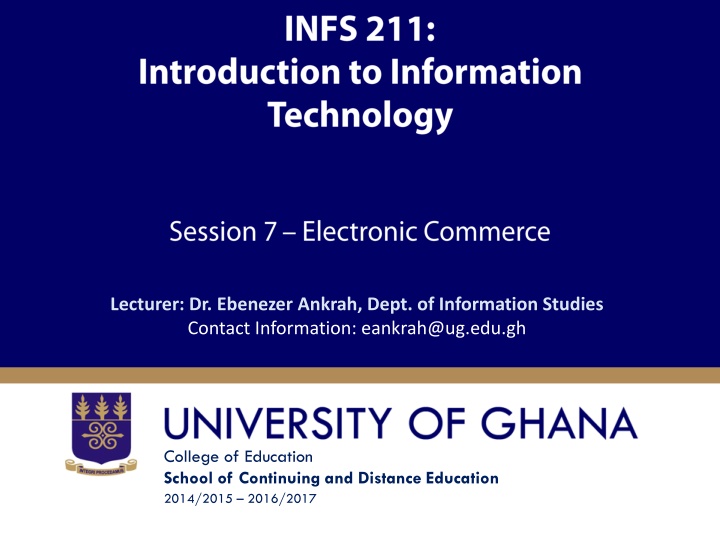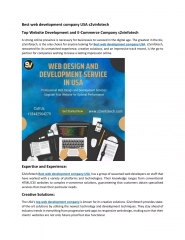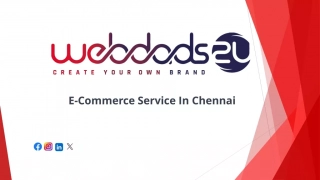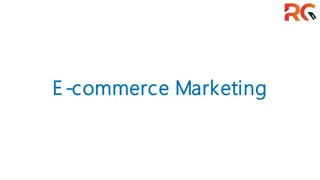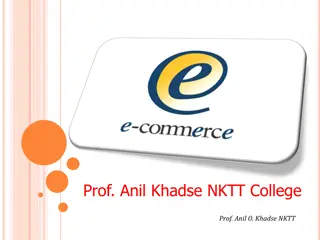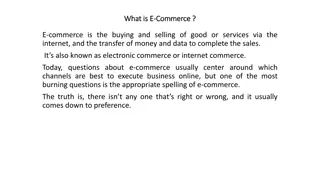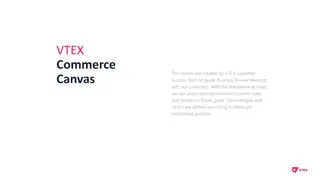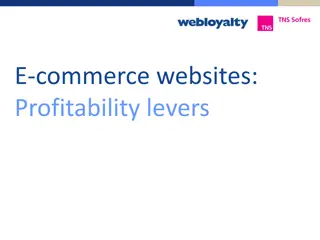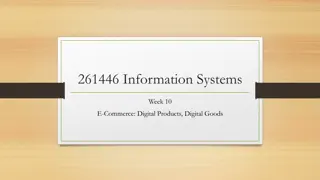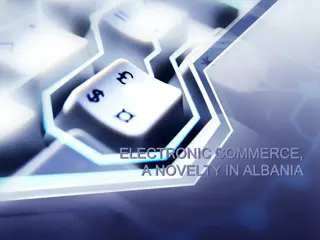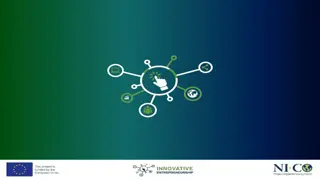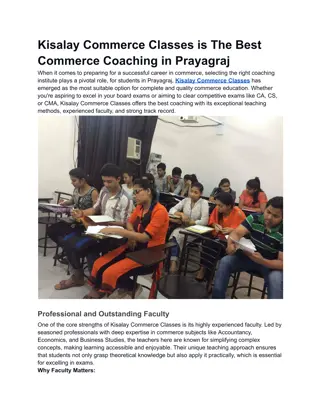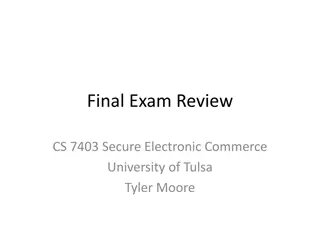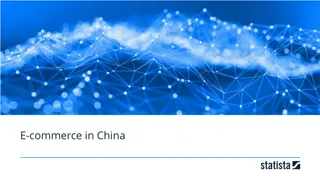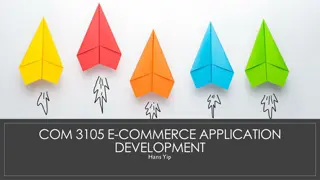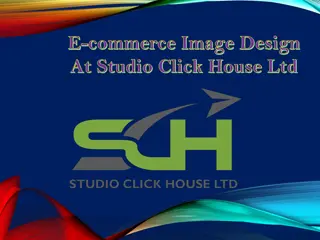Electronic Commerce Fundamentals
Electronic commerce, or E-commerce, refers to online buying and selling transactions conducted over the Internet. Explore topics such as traditional vs. electronic commerce, different types of E-commerce, payment options, and challenges in this field.
Download Presentation

Please find below an Image/Link to download the presentation.
The content on the website is provided AS IS for your information and personal use only. It may not be sold, licensed, or shared on other websites without obtaining consent from the author.If you encounter any issues during the download, it is possible that the publisher has removed the file from their server.
You are allowed to download the files provided on this website for personal or commercial use, subject to the condition that they are used lawfully. All files are the property of their respective owners.
The content on the website is provided AS IS for your information and personal use only. It may not be sold, licensed, or shared on other websites without obtaining consent from the author.
E N D
Presentation Transcript
Lecturer: Dr. Ebenezer Ankrah, Dept. of Information Studies Contact Information: eankrah@ug.edu.gh College of Education School of Continuing and Distance Education 2014/2015 2016/2017
Session Overview The arrival of the Web quickly led to electronic commerce, the buying and selling of products and services through computer network. Indeed online shopping is growing faster, among the best known e-firms are bookseller Amzon.com, auction network eBay and priceline.com, which lets you name the price you are will to pay for airline tickets and hotel rooms. This session seeks to discuss the types of electronic commerce, the difference between traditional commerce and electronic commerce, the payment options and the challenges facing electronic commerce. Slide 2
Session Overview At the end of the session, the student will Be able to identify and explain the types of electronic commerce Understand the difference between traditional commerce and electronic commerce Understand and apply the payment options for electronic commerce. Understand argumentation and how to present arguments in line with the challenges facing electronic commerce Slide 3
Session Outline The key topics to be covered in the session are as follows: Traditional and Electronic Commerce Types of Electronic Commerce Payment Options Challenges facing Electronic Commerce Slide 4
Reading List http://www.tutorialspoint.com/e_commerce/e_commerce_p ayment_systems.htm http://www.ehow.com/info_7998201_types-ecommerce- payment-systems.html http://www.cse.tkk.fi/fi/opinnot/T-109.7510/2006/E- commerce.pdf http://users.ipfw.edu/khamaljn/K490/Readings_files/Challeng esToGlobalEC.PDF Slide 5
Reading List Alan, E., Kendall, M., & Poatsy, M. A. (2015). Technology In Action Complete (12th ed.). Upper Saddle River: New Jersy. Prentice Hall. (Chapter 12) O brien, J. A., & Marakas, G. M. (2011). Management Information Systems (11th ed.). Boston: McGraw-Hill Irwin. (Chapter 8) Slide 6
Topic One TRADITIONAL AND ELECTRONIC COMMERCE Slide 7
Traditional and Electronic Commerce Electronic commerce (E-commerce) is buying and selling of goods over the Internet. E-commerce can also be defined as the process of two or more parties making business transactions via computer and some type of network. Slide 8
Traditional and Electronic Commerce E-commerce is the sharing of business information, maintaining business relationships, and conducting business transactions by means of telecommunications networks. Electronic commerce is the use of the global Internet for purchase and sale of goods and services, including service and support after the sale. The Internet may be an efficient mechanism for advertising and distributing product information. Slide 9
Traditional and Electronic Commerce Four different types of information technology converge to create the discipline of e-commerce. These are; Electronic messages and fax. Sharing a corporate digital library. Electronic document interchange utilizing EDI and electronic funds transfer. Electronic publishing to promote marketing, advertising, sales, and customer support. The major difference between electronic commerce and traditional commerce is the way information is exchanged and processed. Slide 10
Traditional and Electronic Commerce Traditional commerce Face-to-face, telephone lines or mail systems. Manual processing of traditional business transactions. Individual involved in all stages of business transactions. E-Commerce Using Internet or other network communication technology. Automated processing of business transactions. Individual involved in all stages of transactions. Pull together all activities of business transactions, marketing and advertising as well as service and customer support. Slide 11
Topic Two THE TYPES OF ELECTRONIC COMMERCE Slide 12
The Types of Electronic Commerce Electronic commerce involves two parties, namely; Businesses and Consumers. There are three basic types of electronic commerce: Business-to-Business (B2B) Business-to-Consumer (B2C) Consumer-to-Consumer (C2C) Slide 13
The Types of Electronic Commerce Business-to-Business (B2B) B2B involves the sale of a product or service from one business to another. This is typically a manufacturer- supplier relationship. In B2B e-commerce, manufacturers electronically place orders with suppliers and many a times payment is made electronically. The most popular B2B e-commence is for automobile parts, computers and health care. Slide 14
The Types of Electronic Commerce Business-to-Customer (B2C) B2C involves the sale of a product or service to the general public or end users. Often times this arrangement eliminates the middleman by allowing manufacturers to sell directly to customers. Customer-to-Customer (C2C) C2C involves individuals selling to individuals. This often takes the form of an electronic version of the classified ads or auction. Goods are described and interested buyers contact seller to negotiate prices. Slide 15
The Types of Electronic Commerce Benefits of Electronic Commerce Business benefits Reduced costs to buyers from increased competition on- line. Reduced errors, time, and overhead costs of information processing. Reduced inventories and warehouses. Increased access to real-time inventory information, speed-up ordering & purchasing Slide 16
The Types of Electronic Commerce Easily create new markets and get new customers. Automated business processing. Cost-effective document transfer. Reduced business overhead and enhance business management. Marketing benefits Improved market analysis, product analysis and customer analysis. Low-cost advertising. Easy to create and maintain customer on client database. Slide 17
The Types of Electronic Commerce Customer benefits Wide-scale information dissemination. Wide selection of products and services at low cost. Rapid inter-personal communications and information accesses Save shopping time and money. Fast services and delivery. Slide 18
Topic Three PAYMENT OPTIONS Slide 19
Payment Options An e-commerce payment system facilitates the acceptance of electronic payment for online transaction. Also known as a sample of Electronic Data Interchange(EDI), e-commerce payment systems have become increasingly popular due to the widespread use of the internet-based shopping and banking. Electronics Commerce sites use electronic payment where electronic payment refers to paperless monetary transactions. Electronic payment has revolutionized the business processing by reducing paper work, transaction costs and labour cost. Slide 20
Payment Options There are several payment options supporting electronic payments and ecommerce over the internet: Credit cards Debit cards Smart cards Digital wallets (or e-purses) Electronic cash (E-money) Mobile Payment Slide 21
Payment Options Credit cards The most common form of payment for e-commerce transactions is through credit cards. To use this system, shoppers simply enter their credit card number and date of expiry in the appropriate area on a web page. Increased security measures, such as the use of a card verification number (CVN), located on the back of the credit card, have been added to on-line credit card payment systems. The CVN system detects fraud by comparing the CVN with the cardholder's information as supplied by their bank. Slide 22
Payment Options Payment using credit card is one of most common mode of electronic payment. Credit card is small plastic card with a unique number attached with an account. It has also a magnetic strip embedded in it which is used to read credit card via card readers. When a customer purchases a product via credit card, credit card issuer bank pays on behalf of the customer and customer has a certain time period after which he/she can pay the credit card bill. It is usually credit card monthly payment cycle. Slide 23
Payment Options Following are the actors in the credit card system. The card holder - Customer The merchant - seller of product who can accept credit card payments. The card issuer bank - card holder's bank The acquirer bank - the merchant's bank The card brand - for example , visa or master card. Slide 24
Payment Options Debit cards Debit card like credit card is a small plastic card with a unique number mapped with the bank account number. It is required to have a bank account before getting a debit card from the bank. The major difference between debit card and credit card is that in case of payment through debit card, amount gets deducted from card's bank account immediately and there should be sufficient balance in bank account for the transaction to get completed. Whereas in case of credit card there is no such compulsion. Slide 25
Payment Options Debit cards free customer to carry cash, cheques and even merchants accepts debit card more readily. Having restriction on amount being in bank account also helps customer to keep a check on his/her spending. Slide 26
Payment Options Smart Card Smart card is again similar to credit card and debit card in appearance but it has a small microprocessor chip embedded in it. It has the capacity to store customer work related/personal information. Smart card is also used to store money which is reduced as per usage. Smart card can be accessed only using a PIN of customer. Smart cards are secure as they stores information in encrypted format and are less expensive/provides faster processing .Mondex and Visa Cash cards are examples of smart cards. Slide 27
Payment Options Electronic cash An e-commerce system that uses e-cash refers to a system in which money is only exchanged electronically. To use e-cash, link your personal bank account to other payee accounts or set up an e-cash account using a centralized system, such as PayPal, and link it to your personal bank account. To fund your e-cash account, you can debit from your personal bank account or credit card. To make payments using your e-cash account, you can make a deposit to the other person's e-cash account if you have their banking information, or request a transfer to their bank account. Slide 28
Payment Options Electronic money E-Money transactions refers to situation where payment is done over the network and amount gets transferred from one financial body to another financial body without any involvement of a middleman. E-money transactions are faster, convenient and saves a lot of time. Online payments done via credit card, debit card or smart card are examples of e-money transactions. Another popular example is e-cash. In case of e-cash, both customer and merchant both have to sign up with the bank or company issuing e-cash. Slide 29
Payment Options Electronic Fund Transfer It is a very popular electronic payment method to transfer money from one bank account to another bank account. Accounts can be in same bank or different bank. Fund transfer can be done using ATM (Automated Teller Machine) or using computer. Slide 30
Payment Options Now a day, internet based EFT is getting popularity. In this case, customer uses website provided by the bank. Customer logins to the bank's website and registers another bank account. He/she then places a request to transfer certain amount to that account. Customer's bank transfers amount to other account if it is in same bank otherwise transfer request is forwarded to ACH (Automated Clearing House) to transfer amount to other account and amount is deducted from customer's account. Once amount is transferred to other account, customer is notified of the fund transfer by the bank. Slide 31
Payment Options Mobile Payment The newest e-commerce payment system is mobile payment, wherein a consumer uses her cell phone to make purchases. Instead of using cash or credit cards to buy something, the user simply sends a payment request via text message. If the vendor has the mobile billing capability, the consumer's mobile account or credit card is charged for the purchase. To set up a mobile payment system, download a software package from your cell phone company's website, then link your credit card or mobile billing information to that software. Slide 32
Topic Four CHALLENGES FACING ELECTRONIC COMMERCE Slide 33
Challenges facing Electronic Commerce The issues around electronic commerce can be examined at several different. The challenges facing electronic commerce can be categorized into four major dimensions namely economic, technological, social and legal as shown in the table below; Slide 34
Challenges facing Electronic Commerce Economic Cost Justification Technical Social Legal Security, reliability, and protocols Privacy/security Intellectual Property Rights Internet access Bandwidth Cultural diversity Legal validity of transactions Telecom Infrastructure Integration Trust Taxation issues Skill shortage Absence of touch/feel Policing/Regulati on Slide 35
Challenges facing Electronic Commerce The Economic Challenges Some economic considerations in e-commerce are the cost justification of projects, the number of sellers and buyers and their access to the Internet, the issues around infrastructure upgrade, and the question of skill shortage. Justifying the cost of e-commerce projects is a huge challenge. The cost of developing an e-commence project is typically rather high. Further, mistakes due to lack of experience inflate these costs. Slide 36
Challenges facing Electronic Commerce The commercial utility of the Internet rests in large part on the economy being connected - the value of the connection to the Internet increases as others connect, and as the number of buyers and sellers increases. One major area of concern in e-commerce is the construction of a telecommunications infrastructure to support its explosive growth. The current infrastructure is inadequate to support the potential of ecommerce. Most countries will need to completely revamp their telecommunication networks and equipment to take advantage of this new medium. However, the difficult question involves the sources of funding for this massive project that could run into billions of dollars. Slide 37
Challenges facing Electronic Commerce There is a significant hue and cry in the press about the skill shortage and the dearth of information technology personnel trained in EC application development. Numerous hearings in the U.S. Congress have attempted to present evidence that corporations are losing millions of dollars simply because they cannot fill their vacant positions with qualified workers. Slide 38
Challenges facing Electronic Commerce The Technical Challenges The technical considerations are related to security, reliability, communication protocols, bandwidth availability, and integration with existing applications. As the Internet evolves into a global information infrastructure, the issue of security becomes a major concern. Consumers are distrustful about the safety of the information they give out on the web. Recent incidents indicate that relatively unsophisticated hackers can easily steal the information. Slide 39
Challenges facing Electronic Commerce Reliability is another significant concern in electronic commerce. Network infrastructure and application systems have to be continuously upgraded, fine- tuned and maintained to keep the systems running. Evidence indicates that current online systems may not be totally reliable especially when the transaction volume goes northbound Slide 40
Challenges facing Electronic Commerce The question of communication protocols needs attention as e-commerce moves forward along its current path. The current Ipv4 addressing scheme that relies on a 32-bit address system is likely to be a serious limitation as we move into the era of Internet-connected appliances from personal digital assistants to cars. Makers of Internet equipment have not yet adopted the proposed Ipv6 protocol with its 128-bit addressing. As Internet-based commerce enters the sustained development stage, these issues will have to be resolved. Slide 41
Challenges facing Electronic Commerce Insufficient telecommunication bandwidth is another stumbling block in the quest for the rapid expansion of web commerce. There are difficulties in integrating Internet and e- commerce software with some existing applications and databases. Many of the integration solutions are provided by software systems called middleware that connect disparate systems. The middleware are designed to work with popular software systems, but many organizations have homegrown applications or other commercial software for which they develop their own interfaces. Slide 42
Challenges facing Electronic Commerce The Social Challenges There are a number of social/cultural issues that need to be addressed when considering e- commerce. Some of them are the concerns with privacy and security on the Internet, the challenges of cultural diversity, the questions raised by user resistance and inadequate trust, and the absence of a tactile medium for online sales. Slide 43
Challenges facing Electronic Commerce Security and privacy issues are major stumbling blocks for the growth of e-commerce. Consumers hesitate to disclose confidential data such as home address, social security number, and their credit card number over the Internet. A significant percentage of the general public does not believe that conducting business on the Internet is safe. Slide 44
Challenges facing Electronic Commerce The cultural diversity of consumers needs to be taken into account while designing e-commerce sites. The ability to customize the interface for individual/group needs is one of the greatest assets of e-commerce. However, developing an e-commerce site in a fashion that allows it to meet local needs and preferences of many different customer groups is a major challenge for developers. Further, customization tends to be rather expensive. The lack of sophisticated translation tools does not allow an easy translation of web pages from English, the dominant language of the web, into local languages. Slide 45
Challenges facing Electronic Commerce In a traditional business environment, trust is generated transitively from previous personal experiences, or through transparent legislative infrastructures. In the e-commerce environment, an entirely new method of trading, none of these factors may exist. This lack of trust often results in user resistance towards buying products or services through e- commerce. Slide 46
Challenges facing Electronic Commerce As several studies have indicated, the absence of touch and feel in online commerce is a significant problem. However, most businesses are working around this limitation. Slide 47
Challenges facing Electronic Commerce The Legal Challenges Many legal issues are yet to be resolved in this new cyber medium. The legal system gets perplexed with the new challenges that question the validity of existing laws. New laws have to be enacted to take care of the new problems or issues that technology introduces into the society. Slide 48
Challenges facing Electronic Commerce Digital media is vastly different from traditional media such as books, periodicals and journals. It is far more amenable to replication, transmission, and alteration. It is compact and can be stored easily. It is difficult to classify, categorize and catalogue. These characteristics significantly alter the terrain concerning intellectual property rights. The issue becomes even more complicated in the international arena. Slide 49
Challenges facing Electronic Commerce Typically, different countries have different attitudes towards intellectual property rights and despite attempts by global bodies such as the World Trade Organization, the debate around these rights is far from resolved. Furthermore, the manner in which information is obtained and presented on the Web challenges intellectual property protections. Slide 50
